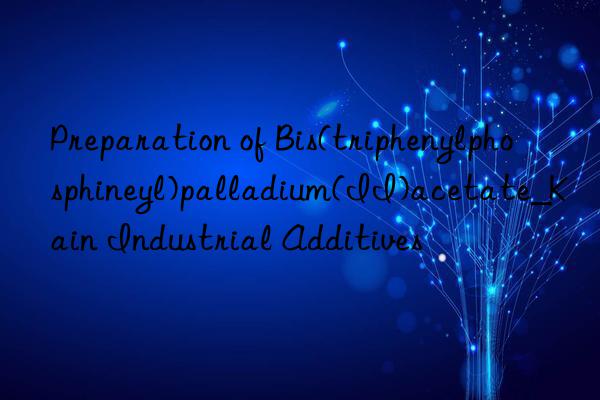
Overview[1]
Among all transition metals, palladium is the most widely used in organic synthesis. Organic palladium complexes can accept many different types of functional groups and can promote various reactions that generate C-C bonds and other bonds. These reactions are often It has high chemical selectivity and regioselectivity. Bis(triphenylphosphine)palladium(II) acetate has excellent catalytic performance in cross-coupling reactions and Suzuki coupling reactions, and is widely used in the pharmaceutical industry and organic industry.
The prior art discloses a preparation method of bis(triphenylphosphino)palladium(II) acetate, which uses bis(benzonitrile)palladium chloride as raw material, and sodium diphenylphosphine acetate in di The reaction in methyl chloride yields earthy yellow diphenylphosphine palladium acetate, which requires the use of benzonitrile highly toxic reagent. The process is complicated and the yield is only 43%. Patent 200410020835. . The preparation of triphenylphosphine palladium acetate has not been reported.
Preparation[1]
The preparation method of bis(triphenylphosphine)palladium(II) acetate is as follows: mix the palladium acetate solution and the triphenylphosphine solution according to the volume ratio of 1: (1.5~5), then react with ultrasonic for 1.5h~5h, and filter , obtaining a yellow crystalline palladium complex; the molar ratio of palladium acetate and triphenylphosphine is 1: (2~2.2); the solvent of the palladium acetate solution is glacial acetic acid, dichloromethane, toluene, dimethyl sulfoxide or N-N-dimethylformamide; the solvent of the triphenylphosphine solution is anhydrous ethanol, dichloromethane, toluene, dimethyl sulfoxide or N-N-dimethylformamide; the temperature of the ultrasonic reaction is 60°C~ 80℃.
The specific method is as follows: Dissolve 0.2g Pd(AC)2 in 10mL glacial acetic acid (toluene, dichloromethane, dimethyl sulfoxide or N-N-dimethylformamide can also be used) to obtain a palladium acetate solution. Dissolve 0.5gPPh3 in 30mL of absolute ethanol (dichloromethane, toluene, dimethyl sulfoxide or N-N-dimethylformamide can also be used) to obtain a triphenylphosphine solution, add the palladium acetate solution to the triphenylphosphine solution , react with ultrasonic at 60°C for 5 hours, then cool and filter to obtain a yellow crystalline palladium complex with a yield of 98.5% and a product mass purity of 99.5%. Elemental analysis of the prepared palladium complex: calculated values, C64.08, H4.80, P8.28, Pd14.20; experimental values, C64.01, H4.79, P8.23, Pd14.15, its infrared The spectrum is shown in Figure 1. It can be seen from the figure that there are two strong absorption peaks at 1648cm-1 and 1430cm-1. The former belongs to the antisymmetric COO- stretching vibration, and the latter belongs to the symmetric COO- stretching vibration. The absorption peaks appearing at 3054cm-1, 1433cm-1, 1080cm-1, 746cm-1, 689cm-1, and 525cm-1 are attributed to the absorption bands of coordinated Ph3P. It shows that COO-, Ph3P and palladium are coordinated to form the palladium complex Pd(PPh3)2(AC)2.
Main reference materials
[1] CN201910375471.3 Preparation method of palladium complex

 微信扫一扫打赏
微信扫一扫打赏

